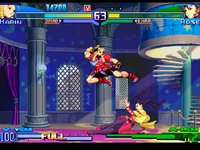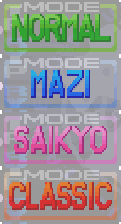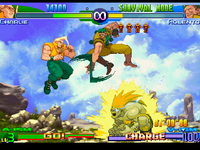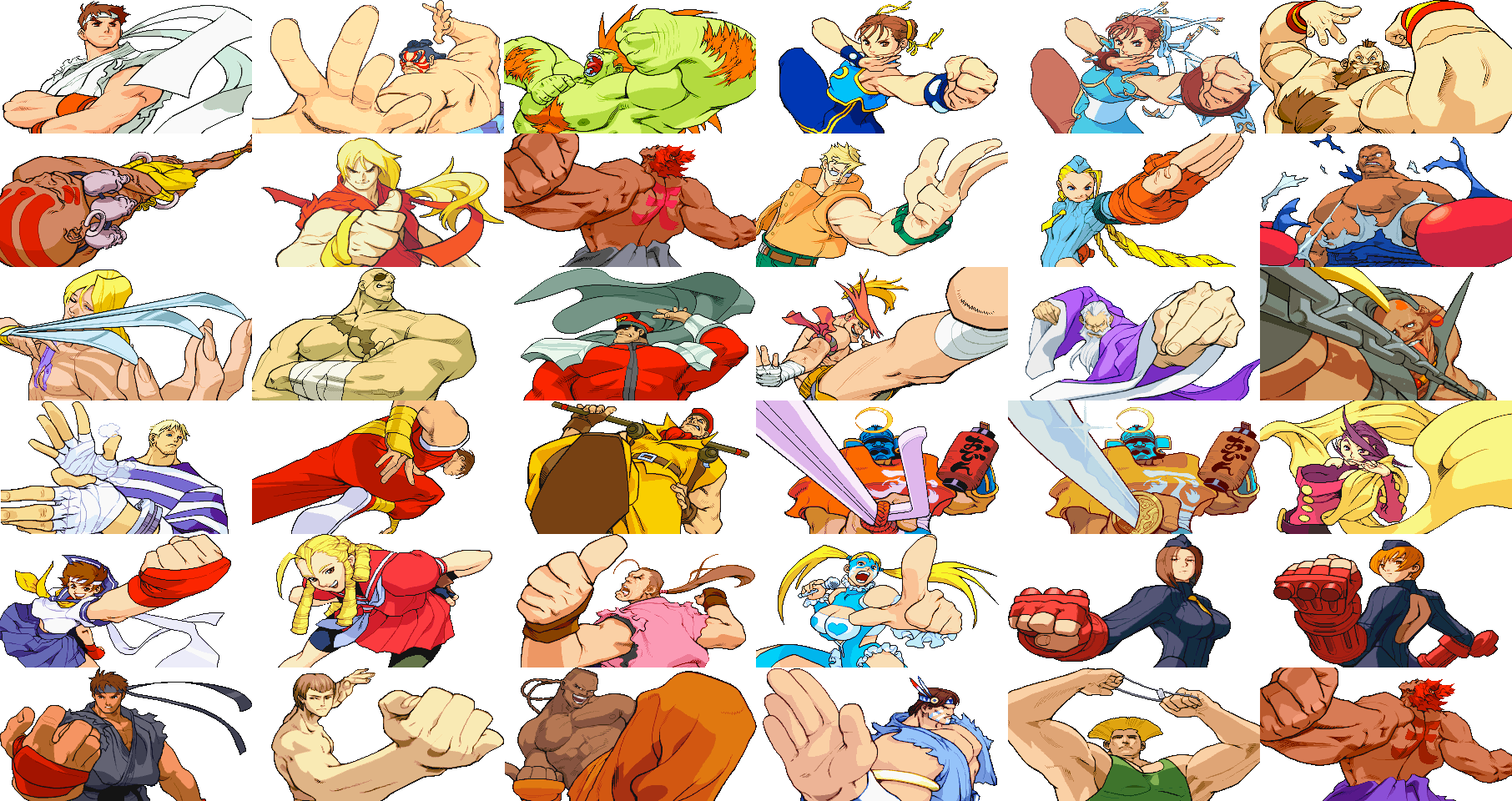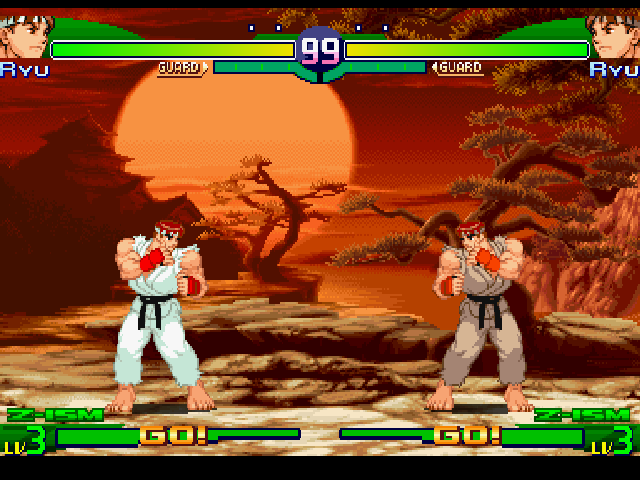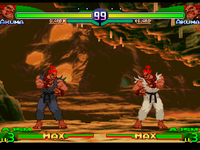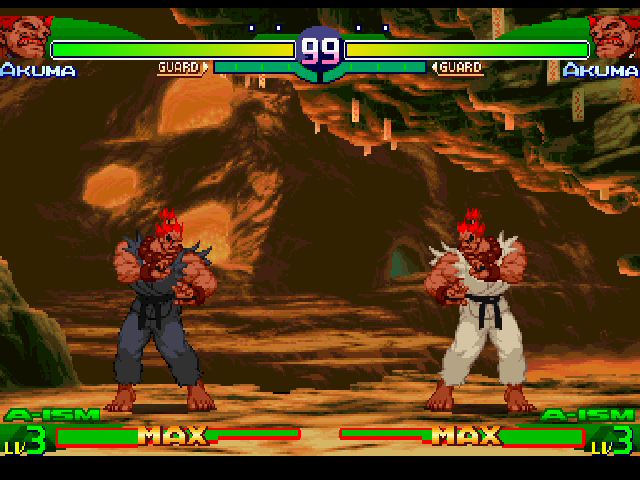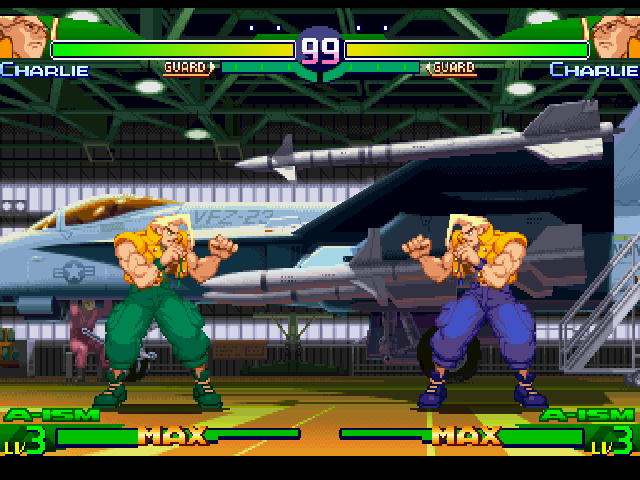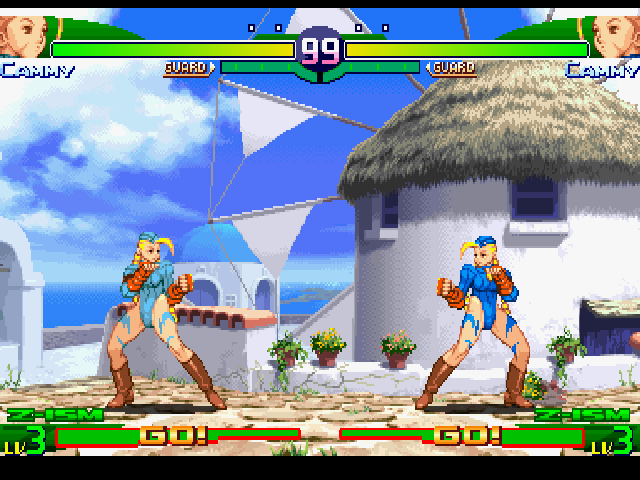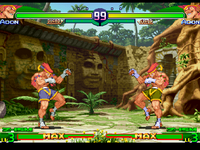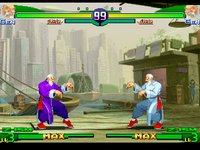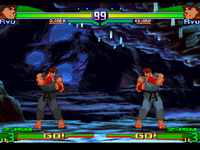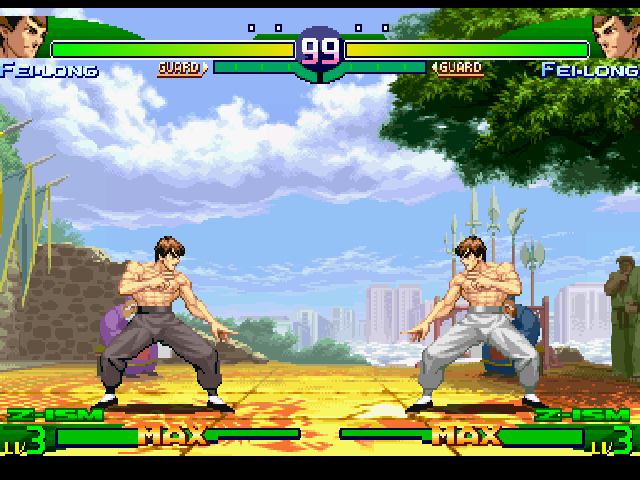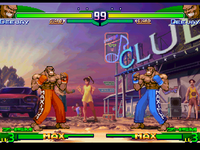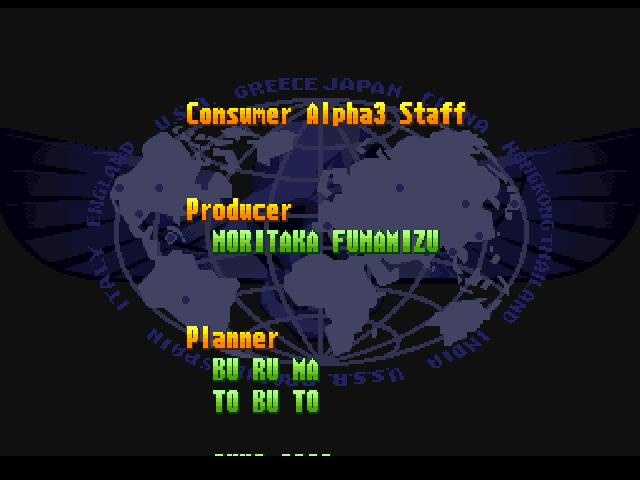Street Fighter Alpha 3
From Sega Retro
- For the Sega Saturn game, see Street Fighter Zero 3.
| ||||||||||||||||||||||||||||||||||||||||||||||||||
| Street Fighter Alpha 3 | ||||||||||||||||||||||||||||||||||||||||||||||||||
|---|---|---|---|---|---|---|---|---|---|---|---|---|---|---|---|---|---|---|---|---|---|---|---|---|---|---|---|---|---|---|---|---|---|---|---|---|---|---|---|---|---|---|---|---|---|---|---|---|---|---|
| System(s): Sega Dreamcast | ||||||||||||||||||||||||||||||||||||||||||||||||||
| Publisher: Capcom (JP), Capcom Entertainment (US), Virgin Interactive Entertainment (Europe) | ||||||||||||||||||||||||||||||||||||||||||||||||||
| Developer: Capcom | ||||||||||||||||||||||||||||||||||||||||||||||||||
| Licensor: Capcom (US, EU), Capcom USA (US) | ||||||||||||||||||||||||||||||||||||||||||||||||||
| Original system(s): Capcom CPS-2 | ||||||||||||||||||||||||||||||||||||||||||||||||||
| Peripherals supported: Dreamcast Arcade Stick, Jump Pack, Dreamcast Modem, Visual Memory Unit, Dreamcast VGA Box | ||||||||||||||||||||||||||||||||||||||||||||||||||
| Genre: Fighting/Taisen Kakutou (対戦格闘)[1][2][1], Action[3] | ||||||||||||||||||||||||||||||||||||||||||||||||||
| Number of players: 1-3 | ||||||||||||||||||||||||||||||||||||||||||||||||||
| ||||||||||||||||||||||||||||||||||||||||||||||||||
|
Street Fighter Alpha 3, known as Street Fighter Zero 3 Saikyou-ryuu Doujou (ストリートファイターZERO 3 サイキョー流道場) in Japan, is a 1998 fighting game by Capcom, originally released for the Capcom CPS-2 arcade hardware. It is the third game in the Street Fighter Alpha series, following Street Fighter Alpha: Warriors' Dreams and Street Fighter Alpha 2.
A revised edition, Street Fighter Zero 3 Saikyou-ryuu Doujou for Matching Service, was released as a mail order title via Dreamcast Direct in Japan in 2001. This version adds an online multiplayer mode.
The subtitle "Saikyou-ryuu Doujou" is a joking reference to the character Dan Hibiki's martial arts school.
Contents
Story
The megalomaniacal dictator M. Bison, leader of the crime syndicate Shadaloo, has infused his body with a dark energy called Psycho Power in order to dominate the world and rule over mankind. His insatiable thirst for power has weakened his body, so he has ordered his scientists to transfer his mind into the body of Cammy, a genetically engineered assassin created using his own DNA as a template. However, Cammy has developed self-awareness and gone rogue, so Bison instead turns his sights to Ryu, one of the strongest fighters in the world and the personal nemesis of his right-hand man Sagat.
Shadaloo scientists have also created a diabolical machine called the Psycho Drive, whose purpose is to channel psychic energies to Bison. The Psycho Drive can be used as an ultimate weapon to shoots beams of deadly psychic energy anywhere in the world, and it can also be used to regenerate Bison and make him essentially invincible. The evil energy emitted by the Psycho Drive and the encroaching threat of Shadaloo has drawn a diverse group of warriors into each other's paths.
Like the previous Alpha games, the story serves as a prelude to the events of Street Fighter II, but it presents a more focused narrative rather than the sparingly interconnected story threads of the earlier games. The story takes inspiration from the 1994 anime Street Fighter II: The Animated Movie.
Gameplay
The gameplay system from the previous Alpha games was given a complete overhaul with the addition of three selectable fighting styles known as "Isms" (X-ism, A-ism, and V-ism), a greatly expanded roster of characters, and for the first time since Street Fighter II, new theme music for all of the returning characters.
The controls for some actions has been modified from previous games. The level of a Super Combo move in A-ism is now determined by the strength of the attack button pressed (for example, medium punch or kick for a level 2 Super Combo), rather than the number of buttons pushed. The button combinations for throwing, ground recoveries, and Alpha Counters have also been changed. Several new mechanics have been added, such as air recoveries, Counter Hits, and the Guard Power gauge.
Characters move with ![]() and
and ![]() and crouch with
and crouch with ![]() . They jump with
. They jump with ![]() and flip back and forth with
and flip back and forth with ![]() and
and ![]() . Punches are done with
. Punches are done with ![]() (jab),
(jab), ![]() (medium), and
(medium), and ![]() (fierce). Kicks are done with
(fierce). Kicks are done with ![]() (short),
(short), ![]() (medium), and
(medium), and ![]() (roundhouse). Light attacks are faster and hard attacks deal more damage. Characters have a wide selection of attacks depending on which button is used and whether they are standing away from the opponent, standing near the opponent (proximity normals), crouching, jumping forwards or backwards, or jumping neutral. Special moves for each character are done by pairing specific directional combinations with an attack button. Interrupting an opponent's attack with another attack performs a Counter Hit, which does additional damage (and knocks the opponent back if the counter attack is a hard punch or kick). Fireballs have been significantly weakened and now do less damage when they travel a longer distance. Characters can perform a taunt once per round with HOLD
(roundhouse). Light attacks are faster and hard attacks deal more damage. Characters have a wide selection of attacks depending on which button is used and whether they are standing away from the opponent, standing near the opponent (proximity normals), crouching, jumping forwards or backwards, or jumping neutral. Special moves for each character are done by pairing specific directional combinations with an attack button. Interrupting an opponent's attack with another attack performs a Counter Hit, which does additional damage (and knocks the opponent back if the counter attack is a hard punch or kick). Fireballs have been significantly weakened and now do less damage when they travel a longer distance. Characters can perform a taunt once per round with HOLD ![]() START (except in X-ism), which is a short animation during which the character is vulnerable to attack.
START (except in X-ism), which is a short animation during which the character is vulnerable to attack.
Throws and grabs are done by holding ![]() or
or ![]() when near an opponent and pressing two punch or two kick buttons simultaneously. The character can "whiff" a grab by attempting it outside of range, leaving the character vulnerable to counterattack. Different characters have different throws available to them, and characters can throw in midair as well. Grapple moves cannot be blocked (including special moves involving grappling), but a player can reduce the damage taken from a fall by likewise holding
when near an opponent and pressing two punch or two kick buttons simultaneously. The character can "whiff" a grab by attempting it outside of range, leaving the character vulnerable to counterattack. Different characters have different throws available to them, and characters can throw in midair as well. Grapple moves cannot be blocked (including special moves involving grappling), but a player can reduce the damage taken from a fall by likewise holding ![]() or
or ![]() and pressing two punch or two kick buttons simultaneously. In A-ism and V-ism, after being hit or blocking in the air, it is possible to roll toward the opponent after landing by pressing two kick buttons simultaneously. After being knocked into the air from the ground, characters can recover by pressing two punch buttons simultaneously (optionally paired with
and pressing two punch or two kick buttons simultaneously. In A-ism and V-ism, after being hit or blocking in the air, it is possible to roll toward the opponent after landing by pressing two kick buttons simultaneously. After being knocked into the air from the ground, characters can recover by pressing two punch buttons simultaneously (optionally paired with ![]() or
or ![]() to flip out of the way).
to flip out of the way).
Blocking is done by holding the D-Pad away from the opponent. Characters can block while standing, which blocks against high and mid attacks but not low attacks (such as sweeps), or crouching, which blocks against mid and low attacks but not high attacks (such as jumping attacks and overhead strikes). Blocking can also be done in midair (except in X-ism), but characters cannot air block against normal attacks from an opponent that is standing on the ground and cannot air block after performing an attack in the air. Special moves still do a small amount of "chip damage" if blocked. The game introduces a Guard Power gauge that depletes each time the character blocks. The gauge starts to replenish after not blocking for a moment. If the gauge is completely depleted, then the character is vulnerable to attacks and cannot block. When broken, the bar shrinks, and it is refilled to its new maximum. It can be shrunk a number of times. The initial size of the Guard Power gauge varies depending on the Ism and the character being played. The Guard Power gauge does not exist in the Survival and Dramatic Battle modes. Blocking an attack right when it is about to hit rather than in advance reduces the amount of Guard Power lost (the character flashes blue when this is successful). Characters can also reduce damage taken by pressing any direction and an attack button simultaneously when being hit (the character flashes red when this is successful). In A-ism and V-ism, characters can perform Alpha Counters (Zero Counter in the Japanese release), special counterattacks that interrupt the opponent's attack while blocking at the expense of some of the Super Combo gauge. Each character has a different Alpha Counter for each Ism.
Characters can become dizzy from being attacked repeatedly; they are uncontrollable and vulnerable in this state but can recover more quickly by rapidly pressing back and forth on the D-Pad along with the attack buttons. It is also possible to escape grabs in this way.
Characters have a Super Combo gauge (or an Custom Combo gauge in V-ism) that fills as the character performs regular and special techniques or takes damage. The Super Combo gauge is used in different ways depending on which Ism is being played. The Super Combo gauge carries over between rounds (but not between battles). Each character starts the match with a fully filled gauge (though this can be changed to empty in the options).
Fighting styles
After choosing a character, the player is asked to choose a Mode and an Ism. Both choices affect how the character is played.
Modes
The Modes are unique to the Dreamcast version of the game. Players choose a Mode in every game mode except Dramatic Battle and Vs Dramatic Battle. Modes modify the difficulty of the game in ways that are independent of the Ism chosen.
| Normal | |
|---|---|
| The character plays as he or she normally does in the arcade release of the game. | |
| Mazi | |
| The damage done by the character is significantly increased, but the character also takes double damage from any attack. While the player must still win the best of three rounds to win, the opponent only needs to win one round to defeat the player. | |
| Saikyo | |
| The damage done by the character is slightly decreased, the character is easier to stun, and the Guard Power gauge is drastically shortened. Normal moves cannot be canceled into special moves or Super Combos, lessening combo potential. | |
| Classic | |
| The player must play in X-ism (skipping the Ism selection). The character has the increased damage of X-ism but also its constraints (for example, no air blocking, recoveries, or Alpha Counters). Furthermore, the character has no Super Combo gauge (and thus cannot perform Super Combos) but also no Guard Power gauge (so blocking can be done without restriction). |
Isms
After selecting a Mode, the player is presented with the choice of three fighting styles, called "Isms." Characters often have slightly different normal and special moves depending on the chosen Ism. Some special moves are performed with different button combinations. Characters have different color schemes depending on the selected Ism (and Chun-Li and Sodom have unique sprites when played in X-ism).
Boss characters such as Juli, Juni, and Final Bison use a special "Shadaloo-ism" when fought, which gives them access to special moves unavailable in standard play.
Additional Isms called "Ism-Pluses" can be unlocked in the World Tour mode.
| X-ism | |
|---|---|
| X-ism is a simple style based on Super Street Fighter II Turbo. X-ism has the highest attack power but least defense. All attacks do more damage, and characters have single-level Super Combo gauges with access to a single but powerful Super Combo move (equivalent to the level 3 move in A-ism). However, characters cannot air block, perform ground recovery rolls or air recoveries, reduce damage taken from hits or blocks, or use Alpha Counters. They also take slightly more damage from attacks, though the Guard Power gauge is longer so they can block more. Characters also cannot taunt in this style, with the exception of Dan. | |
| A-ism | |
| A-ism (Z-ism in the Japanese release) is the standard playing style, based on the previous Alpha games. Characters have three-level Super Combo gauges with access to multiple Super Combo moves. Characters have access to air blocking, ground and air recoveries, and Alpha Counters. Performing a Alpha Counter costs one level of the Super Combo gauge and one notch of the Guard Power gauge. Damage done per hit is average (in between the other two styles).
Each Super Combo technique has three levels, chosen based on the strength of the punch or kick button used to execute the move. Some Super Combos can only be performed at max level. The Super Combo gauge recharges faster than in X-ism, and characters have access to every Super Combo move in A-ism but one (Dhalsim's Yoga Tempest is exclusive to X-ism). | |
| V-ism | |
| V-ism (for "variable" style) is a unique style that allows the player to perform Custom Combos (Original Combos in the Japanese release), similar to Street Fighter Alpha 2. Characters have a single-level Custom Combo gauge and cannot perform Super Combo techniques in this style. Proximity normals are only available by holding away from the opponent while pressing a punch or kick button, which gives the player more control over which attacks are used. Characters have access to air blocking, ground and air recoveries, and Alpha Counters. Performing a Alpha Counter costs half of the Custom Combo gauge and one notch of the Guard Power gauge. Damage done per hit is the lowest of the three styles.
Custom Combos can be started by pressing a punch and kick button of the same strength simultaneously when the gauge is at least half full. This causes the character to move more quickly and attack with much less recovery time, making it easier to chain moves together. There is a moment of invulnerability after initiating an Custom Combo. The Custom Combo gauge drains while it is active, and the combo ends when the gauge is empty or if the character is hit out of it. The Custom Combo gauge recharges quickly, faster than in the other styles. Characters cannot block while performing an Custom Combo, but unlike the previous game, they can move backwards. Charge moves can be performed without charging (for example, the player only needs to press |
Modes
The game has multiple modes:
- Arcade Mode: The single-player mode consists of ten matches against computer-controlled opponents, mostly against randomly chosen characters with random Isms. The fifth and ninth battles are against predetermined opponents depending on the character being played, and they are preceded by brief dialogue scenes between the two characters, similar to the rival battles of the previous Alpha games. The final battle is also against a predetermined opponent, which is Final Bison for almost every character (except the hidden character Evil Ryu, who faces Shin Akuma, and Bison himself, who faces Ryu). The final battle is sometimes preceded by a fight against the Shadaloo enforcer Balrog or a two-on-one fight against the Shadaloo Dolls Juli & Juni. The game can be continued an unlimited number of times, though changing to a different character when continuing starts the player back at the first opponent. A second player can join the game to challenge the other player to a fight by pressing START , with the victor continuing in the tournament. There are eight different difficulty levels for computer-controlled opponents and two game speeds.
- Vs Mode: A dedicated two-player mode. Players choose a character, a Mode, an Ism, a handicap, the game speed, and a stage. The stage is chosen based on the first player's character. The game keeps track of wins and finishers for each player.
- Team Battle: A two-player mode where each player selects up to three characters and plays a single match against each other. The first round pits each player's first character against each other. The winner continues with the same character in the next round, while the loser loses their first character and continues the fight with their second. The match ends when one player has lost both of their characters.
- Training Mode: A single-player mode where the player can practice playing a character against a non-hostile opponent. Both characters have vitality and Super Combo gauges that stay fully replenished. The player can select some options with START , such as whether the opponent blocks attacks or whether the opponent stands, blocks, jumps or whether the opponent is passive, controlled by the computer, or controlled manually (using a second control pad). This menu can also enable attack data, showing the damage and the combos done.
- World Tour: A single-player mode where the player chooses a character and travels to five different locations around the world: Asia, U.S.S.R., Europe, Africa, and America. Each contains several stages, each consisting of one to three battles, which must all be completed in one attempt (or the player must try again from the beginning of the stage). Completing the challenges in all five areas unlocks Akuma's home island, Gokuentou, where a final series of boss fights awaits. There are various battle types with different rules, such as battles where opponents can only be damaged with combos or throws, two-on-one Dramatic Battles, and battles where the player faces multiple foes one at a time on the same vitality bar. The player earns experience for the selected character and Ism whenever a stage is completed, which increases the level of the character (up to level 32) and the character's statistics (normal and special move attack power, Super Combo attack power, defense, Super Combo gauge replenish rate, and stamina). In each area, the player can earn additional Isms called "Ism-Pluses," which provide unique bonuses such as increasing the rate at which the player's Super Combo gauge replenishes, preventing the character from ever being stunned, or allowing the character to perform Custom Combos outside of V-ism. Characters created in World Tour mode can saved to Entry Slots for use in the other game modes. Only six Ism-Pluses can be earned, but they are always active, allowing the player to create a custom style called an "I-Ism." The player can strategize which areas to visit first to decide which Ism-Pluses to obtain.
- Survival Mode: A single-player mode where the player chooses any character and fights a series of opponents in one-round matches. The character's vitality gauge is restored by a certain amount after each match depending on the player's performance: time remaining, vitality remaining, the biggest combo performed, and the finisher used (with Super Combo or Custom Combo finishes awarding the most health). The player only has one chance to succeed; the game ends and cannot be continued if the player loses a match. There are multiple courses available. Three of the courses are against single opponents: Arcade (against all of the characters from the original arcade game), Original (against every character in the home version), and Boss (against Balrog, Vega, Sagat, Juli & Juni, Akuma, Final Bison, Evil Ryu, and Shin Akuma). The remaining courses are against multiple opponents per match, with one or two in battle at a time and the others entering the match when another is defeated: 10 Battle, 20 Battle, 30 Battle, 50 Battle, and ∞ Battle (which determines the number of total opponents fought). The game keeps track of the best playthroughs for each course (determined by completion time and score). There are no Guard Power gauges in this mode, so characters have unlimited blocking.
- Dramatic Battle: A two-on-one fighting mode that can be played by one player or by two players (if the second player presses START on the character select screen). In single-player games, each character is assigned a predetermined partner (for example, Guy is partnered with Cody, and Juli is partnered with Juni). In two-player games, each player can choose any character. Players face six boss characters, ending with Final Bison, in two-on-one fights, with all characters present simultaneously. Characters have separate vitality and Super Combo gauges, and the computer controls the partner character in one-player games. Matches are played to the best of three rounds, and a round is only lost if both characters are defeated. There are no Guard Power gauges in this mode, so characters have unlimited blocking.
- Vs Dramatic Battle: A two-on-one fighting mode that can be played by three players simultaneously. Player can choose any character and any stage. The solo player can set the Super Combo gauge to normal or "plus" (which replenishes much faster) and guarding to normal or reflect (auto-blocking) and also has the option of a handicap to even the odds.
- Final Battle: A single-player mode where the player can choose any character and skip straight to the final battle (which is against Final Bison for most characters and not including the fights against Balrog or Juli & Juni when applicable). The match is not preceded by dialogue as it would be in the Arcade Mode, but the player is rewarded with the character's ending if the battle is won. Like the final battle in the original arcade version, the game cannot be continued if the player loses; instead, the game ends with a bad ending where Bison succeeds in taking over the world (or with Ryu's good ending when playing as Bison).
- Network: The game had a special "Saikyou Doujou" mode where the player could upload World Tour mode I-Ism characters and download master characters to compete against locally. The Matching Service version also contains an online versus mode.
Records, including high scores and the player's progress in the World Tour mode are saved to a VMU.
Characters
Note: Move lists assume that the character is facing right. When facing left, ![]() and
and ![]() should be reversed.
should be reversed.
| P | Any punch button |
| LP | Light punch |
| MP | Medium punch |
| HP | Hard punch |
| K | Any kick button |
| LK | Light kick |
| MK | Medium kick |
| HK | Hard kick |
| TAUNT | Taunt |
For moves that require using the TAUNT button, LP must be held for the entire button combination, finishing with the START button.
Playable
All 21 characters from Street Fighter Alpha 2 return (including Cammy from Street Fighter Alpha 2 Gold and the hidden characters Evil Ryu and Shin Akuma). E. Honda, Blanka, Balrog, Vega, Fei Long, Dee Jay, T. Hawk, and Guile return from Super Street Fighter II, completing the roster from that series, and Cody returns from Final Fight. The characters Karin, R. Mika, and the Shadaloo "Dolls," Juli & Juni, debut in this game.
Evil Ryu, Shin Akuma, Dee Jay, Fei Long, T. Hawk, and Guile were all exclusive to the console releases of the game. Additionally, Balrog, Juli, and Juni, who were playable in the arcade version but had no storylines, have been made part of the default roster and given individual stories and endings.
Originally appeared in: Street Fighter
Fifth battle: Rose
Ninth battle: Ken
Final battle: Final Bison
Dramatic Battle partner: Ken
|
Ryu | |||||||||||||||||
| Ryu is a wandering warrior who tours the world in search of new fighters to challenge in order to improve his skill. He is disciplined in his training, and in his journey to become stronger, he often struggles to resist the temptation of dark power. This inner conflict is outwardly represented by his two counterparts: Ken Masters, his high-spirited training partner and best friend, and Akuma, his cold-blooded rival who represents what Ryu could become if he succumbed to evil. Ryu is being hunted by M. Bison and his Shadaloo forces, who are seeking a new body for Bison's mind. | ||||||||||||||||||
Originally appeared in: Street Fighter II
Fifth battle: Ryu
Ninth battle: Sodom
Final battle: Final Bison
Dramatic Battle partner: Sodom
|
E. Honda | |||||||||||||||||
| E. Honda is a sumo wrestler who is hoping to someday become the greatest sumo wrestler in the world. He has achieved the second-highest rank of Ozeki. He is searching for tough opponents to show the world the strength of sumo wrestling. | ||||||||||||||||||
Originally appeared in: Street Fighter II
Fifth battle: Dan
Ninth battle: Zangief
Final battle: Balrog, Final Bison
Dramatic Battle partner: Dan
|
Blanka | |||||||||||||||||
| Blanka is a beastman from the jungles of Brazil. He was once a young boy named Jimmy who was raised by animals after surviving a plane crash. After climbing onto a poacher's truck to eat a melon, he unwittingly travels back to civilization. | ||||||||||||||||||
Originally appeared in: Street Fighter II
Fifth battle: Birdie
Ninth battle: Cammy
Final battle: Juli & Juni, Final Bison
Dramatic Battle partner: Fei Long
|
Chun-Li | |||||||||||||||||
| Chun-Li is an expert martial artist and a young new Interpol officer who seeks revenge for the death of her father at the hands of M. Bison. She has teamed up with the American soldiers Charlie and Guile against Shadaloo.
In X-ism, she uses her classic sprite, where she wears her qipao from Street Fighter II. | ||||||||||||||||||
Originally appeared in: Street Fighter II
Fifth battle: Rolento
Ninth battle: Chun-Li
Final battle: Final Bison
Dramatic Battle partner: R. Mika
|
Zangief | |||||||||||||||||
| Zangief is a Soviet wrestler and national hero. He has been sent by the Russian President to combat the looming danger of Shadaloo. | ||||||||||||||||||
Originally appeared in: Street Fighter II
Fifth battle: Rose
Ninth battle: Birdie
Final battle: Juli & Juni, Final Bison
Dramatic Battle partner: Rose
|
Dhalsim | |||||||||||||||||
| Dhalsim is an Indian Yogi who has left his village to investigate the disturbance caused by the Psycho Drive. | ||||||||||||||||||
Originally appeared in: Street Fighter
Fifth battle: Karin
Ninth battle: Sakura
Final battle: Final Bison
Dramatic Battle partner: Ryu
|
Ken | |||||||||||||||||
| Ken Masters studied karate under the master Gouken, along with his best friend and rival Ryu. Ken is a foil to Ryu: while Ryu is serious and stoic, has no family, and has no possessions, Ken is brash and stylish, has a girlfriend, and comes from a wealthy family. Ken traveled to the United States to compete in martial arts tournaments while Ryu traveled to Thailand to defeat Sagat, the Emperor of Muay Thai. While searching for his old friend, Ken is captured by Shadaloo and brainwashed in order to lure Ryu to them. | ||||||||||||||||||
Originally appeared in: Super Street Fighter II Turbo
Fifth battle: Adon
Ninth battle: Guy
Final battle: Final Bison
Dramatic Battle partner: Gen
|
Akuma (Gouki) | |||||||||||||||||
| Akuma is a cold and emotionless warrior who has mastered the dark and violent art of the Satsui no Hadou. He wants only to obtain as much power as possible and has been completely consumed by darkness as a result. He is searching for Ryu to tempt him to embrace the Satsui no Hadou. | ||||||||||||||||||
Originally appeared in: Street Fighter Alpha
Fifth battle: Cammy
Ninth battle: Rolento
Final battle: Final Bison
Dramatic Battle partner: Guile
|
Charlie (Nash) | |||||||||||||||||
| Charlie Nash is a Captain in the United States Air Force. He has been investigating Shadaloo and their connections to the military. He is tracking M. Bison with the intention of finding and destroying Shadaloo's secret base. | ||||||||||||||||||
Originally appeared in: Super Street Fighter II
Fifth battle: Dhalsim
Ninth battle: Vega
Final battle: Juli & Juni, Final Bison
Dramatic Battle partner: M. Bison
|
Cammy | |||||||||||||||||
| Cammy is a Shadaloo Doll, a genetically engineered assassin for M. Bison. However, Dhalsim used his spiritual powers to break Shadaloo's mental control over her after she was sent to assassinate him. Newly self-aware, she is resolved to free the other Dolls and confront Bison with them. | ||||||||||||||||||
Originally appeared in: Street Fighter II
Fifth battle: Gen
Ninth battle: Birdie
Final battle: Final Bison
Dramatic Battle partner: Birdie
|
Balrog (M. Bison) | |||||||||||||||||
| Balrog is a former heavyweight boxing champion, barred from fighting after killing someone in the ring. He worked his way up the ranks in Shadaloo and became M. Bison's personal bodyguard. He has been sent to investigate Gen and to apprehend Birdie. All of his attacks are performed with his upper body (punches, elbow strikes, headbutts, and so forth), including those executed with the kick buttons. | ||||||||||||||||||
Originally appeared in: Street Fighter II
Fifth battle: Zangief
Ninth battle: Cammy
Final battle: Final Bison
Dramatic Battle partner: Rolento
|
Vega (Balrog) | |||||||||||||||||
| Vega is a narcissistic Shadaloo enforcer who manages the assassin group, the Dolls. He fights with a claw and wears a mask to protect his face. He has been sent to apprehend a rogue Doll named Cammy. His claw can be broken from blocking too many attacks, reducing the damage of his punches, but he can collect his claw after it breaks off and reattach it. | ||||||||||||||||||
Originally appeared in: Street Fighter
Fifth battle: Dan
Ninth battle: Ryu
Final battle: Final Bison
Dramatic Battle partner: Adon
|
Sagat | |||||||||||||||||
| Sagat is the "Emperor of Muay Thai" and M. Bison's right-hand man. After being scarred and defeated by Ryu, he seeks him out again for a rematch. | ||||||||||||||||||
Originally appeared in: Street Fighter II
Fifth battle: Akuma
Ninth battle: Sagat
Final battle: Ryu
Dramatic Battle partner: Cammy
|
M. Bison (Vega) | |||||||||||||||||
| M. Bison is the dictatorial leader of the criminal organization Shadaloo. In his quest for limitless power, he has been infusing his body with a dark energy called Psycho Power. As his body can no longer withstand this, he has been searching for a new body to use as a host, with the aid of his Psycho Drive. | ||||||||||||||||||
Originally appeared in: Street Fighter
Fifth battle: Ken
Ninth battle: Rose
Final battle: Final Bison
Dramatic Battle partner: Sagat
|
Adon | |||||||||||||||||
| Adon is a Muay Thai master. After defeating his former master Sagat, Adon is now seeking to challenge Akuma, hoping to incorporate the Shun Goku Satsu and perfect the Muay Thai fighting style. | ||||||||||||||||||
Originally appeared in: Street Fighter
Fifth battle: Ryu
Ninth battle: Akuma
Final battle: Final Bison
Dramatic Battle partner: Akuma
|
Gen | |||||||||||||||||
| Gen is an aging Chinese martial arts master. He is searching for a worthy opponent to fight in a "Death Match." Akuma is among those he has deemed worthy, and Gen is wishing to encounter him again.
Gen has two fighting stances with entirely different movesets that he can switch between at any time. The Mantis stance is a more defensive stance with faster but lighter attacks. He can chain light attacks into hard attacks in this stance. The Crane stance is a more offensive stance with slower but stronger attacks. His normals are complex but generally have superior reach and often can hit multiple times. | ||||||||||||||||||
Originally appeared in: Street Fighter
Fifth battle: E. Honda
Ninth battle: Blanka
Final battle: Balrog, Final Bison
Dramatic Battle partner: Balrog
|
Birdie | |||||||||||||||||
| Birdie is an overweight British punk rocker and Shadaloo member who fights using chains. He is trying to find the Psycho Drive in order to overthrow M. Bison and become the new lord of Shadaloo. | ||||||||||||||||||
Originally appeared in: Final Fight
Fifth battle: Birdie
Ninth battle: Guy
Final battle: Final Bison
Dramatic Battle partner: Guy
|
Cody | |||||||||||||||||
| Cody is a former vigilante who became incarcerated after his addiction to street fighting spiraled out of control. He breaks out during a prison riot and looks for new competitors to fight. | ||||||||||||||||||
Originally appeared in: Final Fight
Fifth battle: Karin
Ninth battle: Gen
Final battle: Final Bison
Dramatic Battle partner: Cody
|
Guy | |||||||||||||||||
Guy is a sneaker-wearing "urban ninja" who lives in Metro City. He is a master of the Bushin form of ninjutsu. Sensing a disturbance in the balance of the world, he speaks to his old friend Mike Haggar and learns about a mysterious organization called Shadaloo that Haggar has been investigating for drug trafficking.
| ||||||||||||||||||
Originally appeared in: Final Fight
Fifth battle: Sodom
Ninth battle: Cody
Final battle: Balrog, Final Bison
Dramatic Battle partner: Vega
|
Rolento | |||||||||||||||||
| Rolento is former member of the Mad Gear Gang who is now building an army in order to establish a military utopian nation. Remembering his encounters with Cody in the past, he now wants to try to recruit him into his army. | ||||||||||||||||||
Originally appeared in: Final Fight
Fifth battle: Rolento
Ninth battle: Chun-Li
Final battle: Final Bison
Dramatic Battle partner: E. Honda
|
Sodom | |||||||||||||||||
| Sodom is an American Japanophile and trucker. He is trying to revive the Mad Gear Gang and travels the world seeking out potential recruits.
In X-ism, he fights with a pair of katana, recalling his original appearance in Final Fight. In A-ism and V-ism, he fights with a pair of jitte. | ||||||||||||||||||
Originally appeared in: Street Fighter Alpha
Fifth battle: Guy
Ninth battle: Vega
Final battle: Juli & Juni, Final Bison
Dramatic Battle partner: Dhalsim
|
Rose | |||||||||||||||||
| Rose is an Italian fortuneteller who wields a mysterious energy known as Soul Power. She has learned that she shares some of her soul with M. Bison and now seeks the dictator to destroy him. | ||||||||||||||||||
Originally appeared in: Street Fighter Alpha 2
Fifth battle: E. Honda
Ninth battle: Ryu
Final battle: Final Bison
Dramatic Battle partner: Karin
|
Sakura | |||||||||||||||||
| Sakura Kasugano is a Japanese schoolgirl with an intense fixation on Ryu. She has copied many of his techniques and travels the world hoping to encounter and prove herself to him. | ||||||||||||||||||
Originally appeared in: Street Fighter Alpha 3
Fifth battle: Blanka
Ninth battle: Sakura
Final battle: Juli & Juni, Final Bison
Dramatic Battle partner: Sakura
|
Karin | |||||||||||||||||
| Karin Kanzuki is a wealthy and elitist Japanese schoolgirl and a friend and rival of Sakura (in an analogue to the relationship between Ryu and Ken). She is the only daughter and heir of the Kanzuki Zaibatsu. When Shadaloo threatens her family's corporate interests, she decides to use the family fortune to investigate the organization (bringing the family butler, Ishizaki, along with her). She fights in a style of her own design, called Kanzuki-ryuu. | ||||||||||||||||||
Originally appeared in: Street Fighter Alpha
Fifth battle: Chun-Li
Ninth battle: Sagat
Final battle: Balrog, Final Bison
Dramatic Battle partner: Blanka
|
Dan | |||||||||||||||||
| Dan Hibiki is an arrogant, self-taught martial artist. He created the fighting style Saikyou-ryuu ("Strongest Style"). After avenging his father's death at the hands of Sagat, he now travels in search of new students for his dojo and to prove that Saikyou-ryuu is the best fighting style in the world. | ||||||||||||||||||
Originally appeared in: Street Fighter Alpha 3
Fifth battle: Karin
Ninth battle: Zangief
Final battle: Balrog, Final Bison
Dramatic Battle partner: Zangief
|
R. Mika | |||||||||||||||||
| Rainbow Mika is a rookie wrestler who admires Zangief. She wants to make a name for herself to go pro. | ||||||||||||||||||
Originally appeared in: Street Fighter Alpha 3
Fifth battle: T. Hawk
Ninth battle: Cammy
Final battle: Final Bison
Dramatic Battle partner: Juni
|
Juli | |||||||||||||||||
| Juli is a Shadaloo Doll who has been sent on a mission to assassinate the rogue Cammy. In her travels, she learns that she was once a member of T. Hawk's tribe before being brainwashed to serve Shadaloo. She is fought simultaneously with Juni as a sub-boss in the stories of several characters. | ||||||||||||||||||
Originally appeared in: Street Fighter Alpha 3
Fifth battle: E. Honda
Ninth battle: Ryu
Final battle: Final Bison
Dramatic Battle partner: Juli
|
Juni | |||||||||||||||||
| Juni is a Shadaloo doll who has been assigned to find Ryu so that Shadaloo can obtain more information about him. She is fought simultaneously with Juli as a sub-boss in the stories of several characters. | ||||||||||||||||||
Originally appeared in: Street Fighter Alpha 2
Fifth battle: Sagat
Ninth battle: M. Bison
Final battle: Shin Akuma
Dramatic Battle partner: Shin Akuma
|
Evil Ryu | |||||||||||||||||
| Evil Ryu is a hypothetical form of Ryu if he ever succumbed to the evil spirit of the Satsui no Hadou. He seeks to challenge Shin Akuma to determine which of them is the "supreme master of the fist." | ||||||||||||||||||
Originally appeared in: Super Street Fighter II
Fifth battle: Balrog
Ninth battle: Vega
Final battle: Final Bison
Dramatic Battle partner: Chun-Li
|
Fei Long | |||||||||||||||||
| Fei Long is a kung fu practitioner from Hong Kong. He fought in the streets to develop his skills, attracting the attention of Shadaloo. | ||||||||||||||||||
Originally appeared in: Super Street Fighter II
Fifth battle: Adon
Ninth battle: Sagat
Final battle: Final Bison
Dramatic Battle partner: T. Hawk
|
Dee Jay | |||||||||||||||||
Dee Jay is a Jamaican kickboxer who combines fighting and dancing. After rising to the top of his division, he begins traveling the world looking for new challengers.
| ||||||||||||||||||
Originally appeared in: Super Street Fighter II
Fifth battle: Charlie
Ninth battle: Juli
Final battle: Final Bison
Dramatic Battle partner: Dee Jay
|
T. Hawk | |||||||||||||||||
T. Hawk is a member of the Thunderfoot tribe, who have fallen on hard times as villagers have started disappearing under mysterious circumstances. Believing that Shadaloo, which forcefully relocated his tribe from their homeland, is responsible, T. Hawk begins his search for its leader, M. Bison.
| ||||||||||||||||||
Originally appeared in: Street Fighter II
Fifth battle: Chun-Li
Ninth battle: Charlie
Final battle: Final Bison
Dramatic Battle partner: Charlie
|
Guile | |||||||||||||||||
| Guile is a Commander in the United States Air Force. He has been sent to retrieve his superior and friend Charlie, who has supposedly gone AWOL. |
Hidden
- Main article: Street Fighter Alpha 3/Hidden content.
Originally appeared in: Super Street Fighter II Turbo
Fifth battle: Adon
Ninth battle: Guy
Final battle: Final Bison
Dramatic Battle partner: Evil Ryu
|
Shin Akuma (Shin Gouki) |
| Shin Akuma is Akuma when he is using the full extent of his power rather than holding back as he usually does to avoid ending fights prematurely. He moves more quickly than regular Akuma and can fire Zankuu Hadouken two at a time, more closely resembling his original appearance as a secret boss character in Super Street Fighter II Turbo. | |
Originally appeared in: Street Fighter Alpha 3
Fifth battle: Akuma
Ninth battle: Sagat
Final battle: Ryu
|
Final Bison (Final Vega) |
| Final Bison is the boss form fought by characters in the Arcade Mode. His heavy punches are imbued with Psycho Power, and he has access to the devastating Final Psycho Crusher. |
Stages
Each character has his or her own stage where matches are hosted in single-player games.
History
Sequels and re-releases
The game was later remade for Sega NAOMI GD-ROM arcade hardware as Street Fighter Zero 3 Upper.
Versions
This Dreamcast release is based on the earlier the PlayStation port of the game but with enhancements such as restoring most of the animations that had to be cut for the PlayStation release. As such, it retains the additional features of the PlayStation version, including the extra modes and characters that were absent from the arcade release, though almost all of them are accessible by default rather than requiring the player to unlock them. In the PlayStation version, the Dramatic and Final Battle modes must be unlocked by completing the Arcade Mode on its maximum difficulty setting, and the Team Battle and Survival modes must be unlocked by completing the World Tour mode. Similarly, Guile, Evil Ryu, and Shin Akuma (with a simple button combination) are selectable by default in the Dreamcast version but must be unlocked through the World Tour mode in the PlayStation version. Only Final Bison must be unlocked in the Dreamcast version (by completing the Arcade Mode on its maximum difficulty setting).
The Dreamcast version adds additional fighting styles called "Modes," separate from the Ism system: Normal, Mazi, Saikyou, and Classic. These new styles generally handicap the character to increase the challenge. Also unique to the Dreamcast version are a three-player Vs Dramatic Battle mode and a reworked World Tour mode. The Dreamcast version's World Tour mode differs from the PlayStation and Saturn versions in that the player can only earn six Ism-Pluses but can have all six active at the same time (creating a custom style called an "I-Ism"). The character also has five attributes (Attack, Defense, Super Combo, Gauge, and Stamina) rather than only two, and there are different types of battles and some different Ism-Pluses.
The Dreamcast version also contains an online mode that allows players to display their high scores and a "Saikyo Dojo" mode that allows the player to fight a World Tour mode character against a downloadable "master" character. The Japanese-exclusive Matching Service version adds an online versus mode.
Localised names
| Language | Localised Name | English Translation |
|---|---|---|
| English | Street Fighter Alpha 3 | Street Fighter Alpha 3 |
| English (US) | Street Fighter Alpha 3 | Street Fighter Alpha 3 |
| Japanese | ストリートファイターZERO 3 サイキョー流道場 | Street Fighter Zero 3 Saikyou-ryuu Doujou |
Comparisons
- Main article: Street Fighter Alpha 3/Comparisons.
Production credits
- Producer: Noritaka Funamizu
- Director: Naoto Ohta, Mamoru Ohhashi, Buruma, Ohko Zero5
- Visual Planner: Haruo Murata
- Programer: Cham, Hard.Yas ~?-ism~, Pon, Hyper Shinchan, 24 ~Nishi~, Minomi ~RockMan-ism~, Reiko Toh, Senor, Knight Rider Giu, Ittetsu
- Character Design: Akiman, Osusi
- Title Design: Shoei
- Object Design: Eri-N, Fujihara, Mizuho, Takemoto, Hitoshi Igarashi, Mizupyon, Kimo Kimo Jinzin, Ball Boy, Yuesuke, D-Kurita, A.Iwasaki, Kaname, Fuzii & Peliko, Chimorin Shogun, Sagata, Ikusan Z, Kitasan, Yu-Ten.Nakano, Tomohiko Ohsumi, Hiro, Rumichan, Reiko Komatsu, Kozuchi Tamura, Youichi Matsuo, Makoto Ishii
- Scroll Design: Asae Nisituji-Ba, S.Mukai (Jijii), H.Yonezuka, Kohama Akeguro, Y.Tanoue (Tanopu), Ryo Uno, Yoko.Fukumoto, Takako Nakamura, Kazu.T, A.Ohnishi, N.Niiyama, C.Iwai, Sawatch, K.Yamahashi, H.Ohnishi
- Main Music Compose: Anarchy Takapon
- Sub Music Compose: Yuki Iwai, Isao Abe, Hideki Okugawa, Tetsuya Shibata
- Sound Direction: Hiroaki "X68k" Kondo
- Sound Design: Moe.T, Satoshi Ise
- Voice Actor: Tetsuya Iwanaga, Yuji Ueda, Akiko Kohmoto, Yuko Sasamoto, Masashi Sugawara, Wataru Takagi, Junko Takeuchi, Tomomichi Nishimura, Michiko Neya, Osamu Hosoi, Shin'ichiroh Miki, Yuko Miyamura, Tomoyuki Morikawa, Miho Yamada, Yoshiharu Yamada, Kouichi Yamadera, Jin Yamanori, Greg Irwin
- Test Player: Nuki, M.P Oni-Suzuki, Skill Smith‑Bug, Skill Smith‑TTK, M Kunishige, Miura.F.Katsusuke, Yoshihiro Tomita, Akimori Murata
- Special Thanks: Sakomizu, Neo@G (Ishizawa), Spp Iorya, Satsuma, Takuya Shiraiwa, Erik Suzuki, Dan Okada, Chris Tang, Miki Takano, Maki Yoshiura, The Edge, Super Sailor, and Capcom All Staff
- Market Producer: Kouji Nakajima
- General Producer: Noritaka Funamizu, Yoshiki Okamoto
- Producer: Noritaka Funamizu
- Planner: Bu Ru Ma, To Bu To, Ohko 2800
- Rescue: Bamboo
- Visual Planner: Haruo Murata
- Programer: H.Kuramoto, T.Umezu TypeR, A.Kashimoto, Hiro, Chips, Unamuji, M.Kataoka, Kubori, Y.Tsunazaki, T J, T.Furuko, M.Nakanowatari, T.Ueda, Cham-Z, Hard.Yas -Adj-, Reiko Toh, Minomie Mouse, 24., Hyper Shin, K.R.Giu, Senor, Ittetsu
- Character Design: Wsu, Edayan, Harumaru
- Object Design: Makoto Ishii, A.Kurihara, H.Fujihara, Mizuho, Mizupyon, Takemoto, Igarashi, Rinboku, Tagirin, Hideya.Takada, SagataKafumi, E-Nakamura, A.Iwasaki, Kimo Kimo, Ball Boy, Fujii & Peliko
- Scroll Design: Asae.Nishituji, H.Yonezuka, H.Ohnishi, Kazu.T, Yoko.Fukumoto, Megumi.N, Akiko.Hongo, Tama, Tokio.N, T.Ishikawa
- Music Compose: Anarchy.T, Yuki Iwai, Isao Abe
- Sound Design: Hiroaki Kondo
- Voice Actor: Syozo Iizuka, Tetsuya Iwanaga, Yuji Ueda, Yoshitada Ohtsuka, Akiko Kohmoto, Yuko Sasamoto, Masashi Sugawara, Wataru Takagi, Junko Takeuchi, Toshihide Tsuchiya, Kousuke Toriumi, Tomomichi Nishimura, Michiko Neya, Osamu Hosoi, Shin'ichiroh Miki, Yuko Miyamura, Tomoyuki Morikawa, Miho Yamada, Yoshiharu Yamada, Kouichi Yamadera, Jin Yamanori, Greg Irwin
- Package Illustration: Daigo Ikeno
- Software Manual Design: Y.Uchida
- Network Compose: Ichiro Yunde, Mineyuki Noda, Shin., Netman, T.Ikai, Kobaboo
- Test Player: Yng.J.Matsubara, T.Haze, Koncyan, W.Kusunoki
- Special Thanks: Hattori, M.Takemura, K.Kubota, H.Ojima, H.Ohnuki, A.Terada, and All Capcom Staff
- Market Producer: Kouji Nakajima
- General Producer: Noritaka Funamizu, Yoshiki Okamoto
- Presented by: Capcom
- Manual Design: Hanshaw Ink & Image
- Marketing: Todd Thorson, Sean Mylett, Robert Johnson
- Creative Services: Jennifer Deauville and Marion Clifford
- Pacakge Design: Michi Morita and Jamie Gibson
- Translaton: Masayuki Fukumoto
- PR: Melinda Mongelluzzo, Matt Atwood and Carrie Megenity
- Special thanks to: Tom Shiraiwa, Miki Takano, Bill Gardner, Robert Lindsey, Nate McIlvain Williams, Neal Robinson, Kathy Schoback, Kathy Lange and Mark Galarneau
Magazine articles
- Main article: Street Fighter Alpha 3/Magazine articles.
Promotional material
also published in:
- Electronic Gaming Monthly (US) #130: "May 2000" (2000-04-04)[18]
- GamePro (US) #141: "June 2000" (2000-0x-xx)[19]
Artwork
Physical scans
| 81 | |
|---|---|
| Based on 31 reviews | |
| Dreamcast, JP |
|---|
| Dreamcast, EU |
|---|
Compliance
- Main article: Street Fighter Alpha 3/Compliance.
Technical information
- Main article: Street Fighter Alpha 3/Technical information.
External links
- Capcom USA webpage: Dreamcast
- Sega of America webpage: Dreamcast
- Sega of Japan catalogue pages (Japanese): Dreamcast, Dreamcast (for Matching Service)
References
- ↑ 1.0 1.1 1.2 1.3 http://sega.jp/dc/990501/ (Wayback Machine: 2013-03-15 10:20)
- ↑ File:Sfzero3 dc jp backcover.jpg
- ↑ https://sega.jp/history/hard/dreamcast/software_l.html#tab01 (Wayback Machine: 2020-02-01 22:57)
- ↑ 4.0 4.1 http://sega.jp/dc/010210/ (Wayback Machine: 2014-08-03 23:00)
- ↑ https://groups.google.com/g/rec.games.video.sega/c/HALRzsuSrLA/m/DziHbY0LukAJ
- ↑ 6.0 6.1 GamePro, "November 1999" (US; 1999-1x-xx), page 134
- ↑ http://www.simplygames.com/hires.product.asp?id=SGD245 (Wayback Machine: 2002-01-08 01:19)
- ↑ https://groups.google.com/g/uk.games.video.dreamcast/c/vMXrh4w1IWQ/m/Bozd-LS0uTsJ
- ↑ 9.0 9.1 Computer & Video Games, "November 1999" (UK; 1999-10-13), page 113
- ↑ 10.0 10.1 DC-UK, "December 1999" (UK; 1999-11-22), page 16
- ↑ http://www.centromail.es/top/ficha.asp?codmail=15215&codprov= (Wayback Machine: 2001-09-17 04:08)
- ↑ 12.0 12.1 Revista Oficial Dreamcast, "Enero 2000" (ES; 1999-12-20), page 43
- ↑ http://www.micromania.fr:80/zooms/?ref=16164 (Wayback Machine: 2000-12-15 17:58)
- ↑ http://www.futuregamez.net:80/outnow/dc.html (Wayback Machine: 2001-07-31 23:17)
- ↑ File:Street Fighter Alpha 3 DC arcade credits.pdf
- ↑ File:Street Fighter Alpha 3 DC consumer credits.pdf
- ↑ File:SFA3 DC US Manual.pdf, page 33
- ↑ Electronic Gaming Monthly, "May 2000" (US; 2000-04-04), page 86
- ↑ GamePro, "June 2000" (US; 2000-0x-xx), page 96
- ↑ Arcade, "July 2000" (UK; 2000-06-20), page 73
- ↑ Consoles +, "Décembre 1999" (FR; 1999-1x-xx), page 104
- ↑ Dreamcast Monthly, "November 1999" (UK; 1999-11-18), page 78
- ↑ Dreamcast: Le Magazine Officiel, "Décembre 1999/Janvier 2000" (FR; 1999-12-xx), page 82
- ↑ Dreamcast Magazine, "No. 2" (UK; 1999-10-21), page 80
- ↑ Dreamcast Magazine, "No. 4" (UK; 1999-12-23), page 58
- ↑ Dorimaga, "2002-18 (2002-10-11)" (JP; 2002-09-27), page 32
- ↑ Dorimaga, "2002-18 (2002-10-11)" (JP; 2002-09-27), page 33
- ↑ Dreamzone, "Octobre 1999" (FR; 1999-09-xx), page 97
- ↑ Electronic Gaming Monthly, "April 2000" (US; 2000-03-07), page 158
- ↑ Entsiklopediya igr dlya Dreamcast, "Izdaniye chetvertoye, dopolnennoye" (RU; 2002-xx-xx), page 239
- ↑ Famitsu, "1999-07-16" (JP; 1999-07-02), page 30
- ↑ GamesMaster, "June 2000" (UK; 2000-05-18), page 81
- ↑ Game Informer, "August 2000" (US; 2000-0x-xx), page 86
- ↑ Gamers' Republic, "September 1999" (US; 1999-08-10), page 32
- ↑ Joypad, "Septembre 2000" (FR; 2000-xx-xx), page 160
- ↑ MAN!AC, "09/99" (DE; 1999-08-04), page 45
- ↑ MAN!AC, "12/2000" (DE; 2000-11-02), page 59
- ↑ Mr. Dreamcast, "April 2000" (UK; 2000-03-30<em>No results</em>), page 77
- ↑ Official Dreamcast Magazine, "December 1999" (UK; 1999-11-11), page 94
- ↑ Player One, "Décembre 1999" (FR; 1999-xx-xx), page 126
- ↑ Playmag, "Septembre 2000" (FR; 2000-xx-xx), page 143
- ↑ PSX Extreme, "03/2001" (PL; 2001-0x-xx), page 41
- ↑ Revista Oficial Dreamcast, "Febrero 2000" (ES; 2000-0x-xx), page 54
- ↑ Sega Magazin, "October 1999" (DE; 1999-09-06), page 16
- ↑ Strana Igr, "Fevral 1999 1/2" (RU; 1999-xx-xx), page 50
- ↑ Techno (UK) (+0:00)
| Street Fighter Alpha 3 | |
|---|---|
|
Main page | Comparisons | Hidden content | Development | Magazine articles | Video coverage | Reception | Compliance | Technical information
Prototypes: 1999-10-22
| |
| Street Fighter games for Sega systems | |
|---|---|
| Street Fighter II': Champion Edition (unreleased) | Street Fighter II': Special Champion Edition (1993) | Super Street Fighter II: The New Challengers (1994) | |
| Street Fighter: The Movie (1995) | Street Fighter Alpha: Warriors' Dreams (1996) | Street Fighter II Movie (1996) | Street Fighter Alpha 2 (Dash) (1996) | Super Puzzle Fighter II Turbo (1996) | Street Fighter Collection (1997) | X-Men vs. Street Fighter (1997) | Pocket Fighter (1998) | Marvel Super Heroes vs. Street Fighter (1998) | Capcom Generation: Dai 5 Shuu Kakutouka-tachi (1998) | Street Fighter Zero 3 (1999) | |
| Street Fighter II' (1997) | |
| Street Fighter Alpha 3 (1999) | Street Fighter III: Double Impact (1999) | Street Fighter III: 3rd Strike (2000) | Super Street Fighter II X for Matching Service (2000) | Street Fighter Zero 3 for Matching Service (2001) | Super Puzzle Fighter II X for Matching Service (2001) | |
| Street Fighter Zero 3 Upper (2001) | |
| Sampler discs | |
| Street Fighter Zero 2 Taikenban (199x) | Street Fighter Collection Taikenban (1997) | |
| Street Fighter Zero 3 Tentou Taikenban (199x) | |
| Unlicensed Street Fighter games for Sega systems | |
| Jang Pung II (1993) | |
| X-Men vs. Street Fighter (Mega Drive) (1998) | |
| Final Fight games for Sega systems | |
|---|---|
| Final Fight CD (1993) | |
| Final Fight Revenge (1999) | |
| Related games | |
| Saturday Night Slam Masters (1994) | |
| Street Fighter Alpha: Warriors' Dreams (1996) | Street Fighter Alpha 2 (Dash) (1996) | Street Fighter Collection (1997) | Street Fighter Zero 3 (1999) | |
| Street Fighter Alpha 3 (1999) | |
- Dreamcast Arcade Stick-compatible games
- Jump Pack-compatible games
- Dreamcast Modem-compatible games
- Dreamcast VGA Box-compatible games
- Visual Memory Unit-compatible games
- 1-3 player games
- JP Dreamcast games
- All JP games
- US Dreamcast games
- All US games
- EU Dreamcast games
- All EU games
- DE Dreamcast games
- All DE games
- ES Dreamcast games
- All ES games
- FR Dreamcast games
- All FR games
- UK Dreamcast games
- All UK games
- AU Dreamcast games
- All AU games
- Dreamcast games
- 1999 Dreamcast games
- All 1999 games
- Dreamcast fighting games
- All fighting games
- Dreamcast games sold exclusively through Dreamcast Direct
- Dreamcast games with QSound support
- All games
- Street Fighter Alpha 3
- Street Fighter
- Final Fight (franchise)





